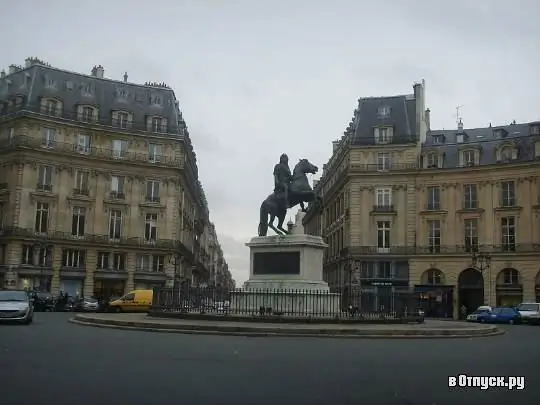
Description of the attraction
Victory Square is one of the smallest in Paris. It lies five hundred meters northeast of the Louvre and was built, like the gates of the Grands Boulevards (Saint-Denis and Saint-Martin), in honor of the victories of King Louis XIV in the war against Holland.
The idea of such a gift to the king came to mind of his marshal de La Feyade. At the conclusion of the Peace of Nimwegen, the marshal bought and demolished all the houses in the chosen place, so that the court architect Jules Hardouin-Mansart smashed and built up a square with a statue of the king in the center.
Mansar conceived a completely round square with facades of houses similar to the walls of a temple. It was here that Mansart first tried such a technique as arranging beautiful attics on houses, later named after the architect. Six narrow streets opened onto the square. In the center, as planned, a pedestrian statue of the king was erected on a high pedestal. In the corners were figures symbolizing the sadness of the triple alliance (England, Sweden, Netherlands) who lost in the war.
During the French Revolution, the monument to the king, who had just been executed by the guillotine, was demolished. The square was renamed the Square of National Victories, referring to the victories of Republican France. A pyramid was installed in the center.
In the time of Napoleon, the pyramid was removed and a nude equestrian statue of General Dese, a participant in the Egyptian campaign who fell in the battle of Marengo, was erected. After the fall of the empire, the bronze from this monument, together with the metal of the figure of Napoleon from the Vendome Column, went to the casting of the statue of Henry IV, which now stands at the Place Dauphin.
After the Restoration, in 1826, a monument to Louis XIV by François Joseph Bosio was again erected on Victory Square. This time on horseback, with a rider in Roman clothes, on a simple pedestal - nothing to do with the original idea.
In the 19th century, some of the houses overlooking the square were rebuilt, the streets were expanded. Not so much remains of Mansar's plan, but the general atmosphere of a small, beautiful square, reminiscent of a ballroom, has been preserved.






